April 14, 2006
Air Date: April 14, 2006
FULL SHOW
SEGMENTS
What's New in Nukes
View the page for this story
The Bush Administration has unveiled its plan to modernize the nation's nuclear arsenal. The plan, called "Complex 2030," would create a new industrial infrastructure to build the next generation of weapons. Living on Earth’s Bruce Gellerman goes over the details with host Steve Curwood. (06:15)
Contaminated Water
View the page for this story
Reports from some troops and company whistleblowers say Halliburton subsidiary KBR supplied contaminated water to military camps in Iraq. Living on Earth's Jeff Young talks with some soldiers who came home sick and wonder if it's from the dirty water. (05:30)
Swamp Songs
View the page for this story
The Okefenokee National Wildlife Refuge in Georgia is made up of almost 700 square miles of wetlands and home to a wide variety of plants and animals. As nature recorder Lang Elliott tells host Steve Curwood, he got up close and personal with his microphone to the wildlife at Okefenokee and he shares some of his sounds. (06:30)
Hip-Hoppity Lady
/ Nina MitchellView the page for this story
Easter time means bunnies. Lots of them. The demand for rabbits has business booming. Nina Mitchell profiles one successful bunny business lady. (05:00)
America's Report Card on the Environment
View the page for this story
A Stanford University poll shows that 60 percent of American people are pessimists when it comes to the environment. The survey’s architect, Jon Krosnick, breaks down the numbers and tells host Steve Curwood that global warming is an increasingly personal concern for Americans. (06:00)
Note on Emerging Science
/ Emily TaylorView the page for this story
Is natural selection sexist? Some new data says women are living longer than men in almost every nation in the world. Living on Earth’s Emily Taylor reports. (01:30)
Early Signs: Water Disappearing
/ Aaron SelverstonView the page for this story
For low-lying coral islands in the South Pacific, the warming of the planet and its atmosphere is not an abstraction, it's a reality. In the fifth in a series on early signs of climate change around the globe, Aaron Selverston reports from the island nation of Kiribati (kiri-bahs). (12:45)
This week's EarthEar selection
listen /
download
Sounds from the Jungle of Borneo, where Jean Roché recorded the dawn chorus along the banks of the Kinabatangan River.
Show Credits and Funders
Show Transcript
HOST: Steve Curwood
GUESTS: John Krosnik, Lang Elliot
REPORTERS: Bruce Gellerman, Jeff Young, Nina Mitchell, Aaron Selverston
NOTE: Emily Taylor
[THEME MUSIC]
CURWOOD: From NPR, this is Living on Earth.
[THEME MUSIC]
CURWOOD: I’m Steve Curwood. The Bush Administration wants a new generation of nuclear weapons, but its plan leaves enough plutonium to make hundreds of bombs near major population centers for years. And that has the government’s own science advisors concerned.
OVERSKEI: If you look at their plan, all of the difficult issues are moved off to another administration. It’s a political calculus.
CURWOOD: Also, allegations that a defense contractor sickened soldiers in Iraq by giving them dirty water.
CARTER: We’re supposed to be supporting the troops. And the last thing they need after being out on patrol all day is to be attacked by water borne pathogens.
CURWOOD: Those stories and…voices from the swamp –
[SWAMP SOUNDS]
CURWOOD: This week on Living on Earth. Stick around.
[NPR NEWSCAST]
ANNOUNCER: Support for Living on Earth comes from the National Science Foundation, Stonyfield Farm, and Kashi, maker of crackers, granola bars and cereal, made from seven whole grains. Learn more at Kashi.com
[THEME MUSIC]
What's New in Nukes
CURWOOD: From the Jennifer and Ted Stanley studios in Somerville, Massachusetts, this is Living on Earth. I’m Steve Curwood.
President Bush says the United States needs to modernize its strategic nuclear arsenal to make it more secure, reliable, and make the weapons better designed for the threats of the 21st century. Recently the administration unveiled a plan that would radically overhaul America’s nuclear bomb building infrastructure.
Living on Earth’s Bruce Gellerman has been investigating the plan, called “Complex 2030,” and he joins me now in the studio. Hi Bruce.
GELLERMAN: Hi Steve.
CURWOOD: Now, I thought we were supposed to be getting rid of nuclear weapons?
GELLERMAN: Well, we are. We’ve got about 7,700 nuclear weapons in the strategic arsenal. By treaty with Russia we’ve got to reduce those to 2,200, and we’re working right now dissembling them at a nuclear plant in Amarillo, Texas
CURWOOD: So why are we building new nuclear weapons?
GELLERMAN: Well you mentioned in your introduction that they want to make weapons that address the threats of the 21st century. The weapons that we are designing now were designed basically in 1960s, 70s, 80s. We haven’t produced a nuclear weapon in this country since 1989 – that’s 17 years ago – in plants that were basically constructed after World War II.
CURWOOD: So what kinds of new weapons do they want to build?
GELLERMAN: Something called the “reliable replacement warhead.” You’re gonna hear a lot about this in the near future I think, Steve. The weapons that they want to build are going to be a new generation of weapons. They’re going to be supposedly safer, that is, they’re harder to trigger accidentally. They’re easier to manufacture. They eliminate many of the materials that are environmentally dangerous – producing nuclear weapons is a very environmentally-unfriendly thing to do. And they want to ensure the reliability.
CURWOOD: And are there particular kinds that they want to make?
GELLERMAN: Well, yeah, things like “bunker-busters.” You know, right now in the arsenal they’ve got weapons that can burrow down about a hundred feet into the earth; they want to go a thousand feet.
CURWOOD: Now, speaking of reliability, the weapons we have now might not be reliable? The president could go to push that big button and nothing would happen?
GELLERMAN: Well, the National Nuclear Safety Administration, which oversees the industry which produces nuclear weapons in the United States, says no, the stockpile is safe and secure. But they say we need new facilities.
One of the issues is that, by treaty, in 1992 we stopped doing underground testing. So they really don’t know if these things are going to go bang when they push the button. The problem is the heart and the sole of these nuclear devices. They’re called plutonium pits. We haven’t made those in about 20 years. And some scientists believe they may be corroding and deteriorating and may not work.
CURWOOD: So the idea of this “Complex 2030” nuclear weapons building plan is to make them safer at home and more modern, then?
GELLERMAN: Absolutely. These are sweeping changes, Steve. There was an advisory board that was convened by the National Nuclear Safety Administration’s parent body, which is the Department of Energy. And this advisory board was praised by the administration for their recommendations, but they differed in one significant way.
CURWOOD: And what was that?
GELLERMAN: Well let me read from the report. It says, “we agree with much of what the task force recommends, except in one critical area: we simply cannot commit to a consolidated nuclear production center.”
What the task force recommended was putting everything in one place. Right now we’ve got an industry just spread over eight states, coast to coast, and the problem, especially after 9/11, is security. They’re taking this stuff and moving it all around, and it’s a weak link.
And I spoke to the chairman of this task force that made this recommendation to put everything in one place. His name is David Overskei.
OVERSKEI: These components, if they’re in disparate parts of the country, they have to be transported from one location to the other – at some point they need to be assembled. And if you have the production of the plutonium and the production of the uranium at the same location where the components are brought together and assembled, you’ve removed an enormous transportation and, therefor, security risk from the complex.
CURWOOD: Sounds to me like that would improve security. Why is the administration opposed to this?
GELLERMAN: Well they say they simply can’t afford it. It’s too much money. What they do agree with the task force is that there should be a consolidation of special nuclear materials, plutonium, which is dangerous and spread all over the country.
CURWOOD: So what does the administration propose doing with all the plutonium?
GELLERMAN: Well they want to put it in one place. They just haven’t decided which place they’re gonna put it. But there’s plutonium all over the country, Steve. You’ve got these eight sites, and most of them have plutonium. And that’s the big problem here.
For example, Lawrence Livermore National Laboratory. It’s just east of San Francisco. There are seven million people living within 50 miles of the lab. The lab is certified to have 1,500 pounds of plutonium. They recently got permission from the government to double that. People in the communities are up in arms. They want that plutonium out. Now, the government says we’ll get it out, we’ll get it out by 2014. And Dr. Overskei says, Hey, why can’t it happen right now?
OVERSKEI: Admittedly, this is a very aggressive schedule, but the amount of material that needs to be moved is not such an amount that it requires six years for removal. As a matter of fact, if you look at their plan, all of the difficult issues are moved off to another administration. It’s a political calculus.
CURWOOD: Bruce, what does Congress say about this plan? Particularly plutonium?
GELLERMAN: Well the administration wants to start putting together new plutonium pits – 125 plutonium pits a year – and Congress so far has been saying no way.
There’s an interesting footnote to this story, Steve. The Secretary of Energy’s advisory board that created the task force that Dr. Overskei chaired was just disbanded. The secretary says he doesn’t need it, he knows what direction to take the department in. And it’s interesting, the advisory board was in business since the Carter administration, more than 30 years ago, and it was designed to deal with politically charged and technically challenging issues just like this one.
CURWOOD: Living on Earth’s Bruce Gellerman, thanks so much.
GELLERMAN: You’re welcome.
Related link:
National Nuclear Security Administraon – to read Defense Program Testimony
[MUSIC: Tex La Homa “Feel Tied Down” from ‘Room Full of Tuneful’ (Melodic - 1999)]
Contaminated Water
CURWOOD: The Inspector General of the United States Army is probing allegations that a subsidiary of the Halliburton Corporation supplied contaminated water to U.S. troops in Iraq. A company whistleblower says errors in water treatment may have put thousands of soldiers at risk of waterborne diseases when they showered, shaved and brushed their teeth. And some troops have returned from Iraq with illnesses their doctors can’t diagnose. They want to know if there’s a connection. Living on Earth’s Jeff Young reports.
YOUNG: As an Army Captain, Matt Harrison served at camp Ar Ramadi near Iraq’s Sunni triangle. He got sick while he was there and still suffers a chronic gastrointestinal disorder. But what really makes him queasy is news that his illness may have come from contaminated water supplied by a military contractor.
HARRISON: It’s sickening to me. I can’t think of words to describe it because it’s so frustrating and upsetting. Especially to guys over there risking their lives day in day out.
YOUNG: Halliburton subsidiary KBR supplies water to Ramadi and other military camps in Iraq. Former KBR employee Ben Carter first noticed a problem with the water last March.
CARTER: It was coming from the Euphrates River. Which is highly contaminated. It absolutely needed to be chlorinated and filtered. I later found out that wasn’t being done, either, the filtration.
YOUNG: Carter fixed the problem at the camp for KBR employees and told his manager the military should be notified.
CARTER: She told me that the military was none of my concern and I was only to take care of the KBR man camp. That was shocking to me. I knew I had to make a decision shortly on whether I was willing to keep my mouth shut and accept a paycheck in exchange for knowing that the soldiers I thought I was there to help were gonna be at risk daily.
YOUNG: Carter quit and brought his complaint to a hearing of the Senate Democratic Policy Committee. The Committee also received an email from Army Captain Michele Callahan, a brigade surgeon at Ar Ramadi.
In January, Captain Callahan writes, she saw an increase in soldiers with bacterial infections, including skin abscesses and conjunctivitis. All the soldiers showered in the same area, and tests found the water contaminated with bacteria. Callahan had a colleague trace the water supply and found KBR used wastewater from a reverse osmosis treatment unit for the camp’s showers.
Tufts University Public Heath professor Jeffrey Griffiths told the committee that defies basic practice and common sense.
GRIFFITHS: In what appears to be a profound misunderstanding of the way a reverse osmosis unit works, this concentrated, untreated, polluted water was provided to soldiers for hygienic purposes that was highly likely to make them sick. They would have been better off with water directly out of the Euphrates River.
YOUNG: The committee also released an internal report by Halliburton employee Will Granger, who investigated Carter’s original complaint. Granger concluded there was no disinfection and no way of knowing how many troops had been exposed to potentially harmful water. Granger called it quote “a near miss. The consequences could have resulted in mass sickness or death.”
Halliburton declined to participate in the hearing and a company public relations officer declined to be interviewed for this story, referring instead to a press release on the company’s web site and a report disputing Granger’s findings. North Dakota Democratic Byron Dorgan criticized the company’s response.
DORGAN: I’m surprised that the company we’re paying seems to be producing reports to undermine its own employee’s conclusions, and seems to be producing reports that are at odds with the conclusions of an army physician who’s on the scene, on the ground, in Iraq.
YOUNG: Without full disclosure from the company it’s difficult to determine what illnesses might have resulted. There are many ways to get sick in Iraq. A study by the Association of Military Surgeons found nine percent of all soldiers evacuated from Iraq suffered digestive problems. Former Marine Todd Bowers says stomach ailments were common in his unit.
BOWERS: Everybody got it. I have some funny videos of all of us crawling around on the ground when we were very, very ill. So it happened on a regular occurrence.
YOUNG: It was not so funny when Bowers returned stateside still so sick he went to the hospital. He thinks it’s possible he used water supplied by KBR, and it’s put a fire in his belly, you might say, to learn more. Bowers is out of the military now and works for a nonprofit called Project on Government Oversight. His job there is to investigate KBR’s water contract.
BOWERS: What was the quality of water, the quantity, how was it transported, every little detail can have an effect on troops over there, how their health is.
YOUNG: Former KBR employee Ben Carter also came home sick. He also thinks it’s from the tainted water, and he’s trying to get workers’ compensation from the company. Carter says he and the soldiers deserve more information.
CARTER: They owe them that, at least. We’re supposed to be supporting the troops. And the last thing they need after being out on patrol all day is to be attacked by water borne pathogens.
YOUNG: The group Iraq and Afghanistan Veterans of America hopes to find sick soldiers and get them information that might be useful in diagnosis and treatment. And the Army wants more information, too. Its Inspector General says an audit of the KBR contract will be a high priority. For Living on Earth, I’m Jeff Young in Washington.
Related links:
- Halliburton employee Will Granger’s report (posted by Democratic Policy
- Email from Army Capt. Michelle Callahan (posted by Democratic Policy
- Hallliburton press release and Allen report
[MUSIC: 16 Horsepower “Flutter” from ‘Folklore’ (Jet Set Records – 2000)]
CURWOOD: Coming up: voices from the swamp. An audio tour of the great Okefenokee. Stay tuned to Living on Earth.
[MUSIC: Axiom Funk “Telling Time” from ‘Funkcronomicon’ (Axiom/PGD – 1995)]
CURWOOD: It’s Living On Earth, I’m Steve Curwood
[SWAMP SOUNDS]
Swamp Songs

A pig frog. (Photo: Lang Elliott ©)
CURWOOD: Swamps have a reputation for being dark and mysterious. But many of them are complex ecosystems filled with large numbers of animals and plants. The Okefenokee National Wildlife Refuge in Georgia is one such place. At almost 400,000 acres, it’s one of the largest wetlands in the United States, and it’s the largest peat-producing bog swamp in North America. The swamp is one of Lang Elliott’s favorites. He’s a nature recordist and photographer, and he joins me now. Lang, welcome back to Living on Earth.
ELLIOTT: It’s a pleasure being here, Steve.
CURWOOD: Lang, now you recorded the sounds we’re hearing at dawn in the Okefenokee National Wildlife Refuge. What do you see as you look out into the early morning swamp?
ELLIOTT: Well, this recording was made at the edge of a large wet prairie. You’re looking out over a vast open area that superficially looks like an African savanna with patches of trees. But those are actually patches of bald Cyprus, and all the open areas is very wet. If you tried walking out there you’d be over your head in water almost instantly.
CURWOOD: Why swamps? What attracts you to them?
ELLIOTT: I love swamps because the soundscape is so remarkable. You have frogs going, you have various wading birds making sounds, you have an abundance of sounds coming from songbirds in the shrubs and patches of trees along the edges of the swamp. It’s the North American equivalent of being like in a tropical rainforest kind of situation, at least soundscape-wise.

A pig frog. (Photo: Lang Elliott ©)
ELLIOTT: Well, a variety of things. I was along a boardwalk on the east side of Okefenokee National Wildlife Refuge, and one of the first things I recorded was some sound coming from a thicket of shrubs next to the boardwalk. And it’s the call of the yellow-billed cuckoo, which is a relative of the common cuckoo of Europe that goes “cuckoo, cuckoo.” But this one goes “caup, caup, caup, caup.”
[YELLOW-BILLED CUCKOO CALL]
ELLIOTT: Other sounds included the call and the drum of a pileated woodpecker. Pileated woodpeckers really love southern swamps, where they nest in hollows or dig out their nest in rotting tree trunks. They’re a very common species in southern swamps.
[DRUMMING AND CALL OF PILEATED WOODPECKER]
ELLIOTT: I love that call. It sort of sounds like something Woody Woodpecker would do.
CURWOOD: (Laughs)
ELLIOTT: Another interesting bird in the Okefenokee wet prairies is the Sandhill Crane, which has a marvelous clamoring, guttural call.
[SANDHILL CRANE CALL]
CURWOOD: That’s an interesting call. Is that a male or female?
ELLIOTT: It’s actually both sexes. That is the unison call of the Sandhill Crane given by mated pairs during the breeding season. And one bird gives a lower, guttural call and the other gives a higher call, a higher sort of doubled-call, and it sounds like “ghroo ka-ka ghroo ka-ka ghroo ka-ka ghroo ka-ka.”
[UNISON CALL OF SANDHILL CRANES]
CURWOOD: Now, Sandhill Cranes mate for life?
ELLIOTT: Yes they do. They have what’s called “perennial monogamy,” meaning they are monogamous, but they reform their pair bonds each spring.
[SANDHILL CRANES]
CURWOOD: Now when I think swamp, I think gator. Alligator.
ELLIOTT: Yes, and there are lots of alligators in Okefenokee. There’s some really big ones. And the recording I got was actually along that boardwalk. It was about a seven-foot-long alligator. Not too big, but, you know, one I wouldn’t want to stick my hand in front of its nose. It wasn’t really making any noise, so I sort of poked at it with my shotgun microphone. I didn’t actually touch it, I just sort of waved it out in front of it.
[ALLIGATOR SNORT]
ELLIOTT: And it responded with a loud snort followed by this hissing noise. It was quite a remarkable sound.
[ALLIGATOR SNORT AND HISS]
CURWOOD: Sounds like somebody trying to start an engine that won’t go.
ELLIOTT: Right, yeah, it does have that, especially the second part of that snort where you hear the vibration in the call.
[HISSING]
CURWOOD: Now we couldn’t go to the swamps without having a bunch of frogs, too, right?
ELLIOTT: That’s right.
CURWOOD: What are some of the most prominent ones there?
ELLIOTT: Well, the most prominent frog, I believe, in Okefenokee, the one that everyone hears – you can hear it day and night – is the pig frog, which grunts like a pig.
[GRUNTING OF PIG FROG]
ELLIOTT: It actually looks like a bullfrog, about the size of a bullfrog, and some people mistake them and even their sounds for bullfrogs. But they’re actually a frog of southern swamps. Very common all through the South.
CURWOOD: I understand you got up close and personal with one of these frogs.
ELLIOTT: Oh yes. Very often if you capture one – and you don’t have to hurt it or squeeze it – but it will give a distress call that’s really quite a remarkable sound.
[PIG FROG DISTRESS CALL]
ELLIOTT: Sounds like he’s gagging.
CURWOOD: It sounds very sad to me, like he wants his moooooooooom.
ELLIOTT: Somehow I doubt if he’s calling for his mom. (Laughs)
CURWOOD: Lang Elliott travels far and wide to record the natural world with his digital recorder and camera. His new book coming out this fall is called “Songs of Wild Birds,” and it’ll include a CD. Lang, thanks for joining us.
ELLIOTT: It was a pleasure being here, Steve.
Related links:
- mole cricket
- common nighthawk
- chuck-wills
- barred owl
- night chorus of insects and chuckwills
- Okefenokee National Wildlife Refuge
- A map of Okefenokee National Wildlife Refuge (pdf)
[PIG FROG DISTRESS CALL AND SWAMP SOUNDS]
Hip-Hoppity Lady

One of Laura’s “hoppers” (Courtesy of Laura McKenzie)
CURWOOD: According to the American Pet Products Manufacturers Association, there are nearly seven million pet rabbits in the United States. And around Easter time, the demand for the fluffy critters starts hoppin’. Nina Mitchell visited one breeder to learn the ins and outs of raising rabbits.
MITCHELL: In a modest beige house on a crowded little street in Watertown, Massachusetts, lives Laura McKenzie, the Rabbit Lady.
McKENZIE: If I go into public places and people know my daughter, the parents will say, “There’s the Rabbit Lady.” And I just want to cringe when I hear that. Now I’ve gotten used to it, so now I just accept it.
MITCHELL: It all began 11 years ago, when Laura’s husband, John, wanted a pet.
JOHN McKENZIE: I just wanted one rabbit! (Laughs)
MITCHELL: Now they have 37.
[RABBIT SOUNDS]
MITCHELL: That’s Betsy. Betsy looks like she has rabbit highlights. Her fur is fiery red-brown with the occasional darker stripes. Rabbits are usually quiet animals, but when they’re pregnant, they make noises burrowing in their cages. That’s what Betsy’s doing now.
[RABBIT SOUNDS]
MITCHELL: The McKenzie’s seem destined for more rabbits soon.
[RABBIT SOUNDS]

One of Laura’s “hoppers” (Courtesy of Laura McKenzie)
McKENZIE: I play music so that they are acclimated to noise. And also to soothe them. I mean they sit in here in the garage and it probably gets lonesome.
MITCHELL: And the Rabbit Lady plays only one kind of music.
McKENZIE: Only classical. Because classical varies in instruments, and it’s soothing. Sometimes you will hear Japanese. You’ll hear all kinds of things on there. I think it’s incredible. I want my bunnies to be educated bunnies. (Laughs)
[CLASSICAL MUSIC]
MITCHELL: Helping Laura tend her bunny colony are students from the local 4H club. They feed the rabbits, clean the cages, brush the animals’ fur till it gleams. 14 year old Katelynn Schultz goes to Watertown Middle School.

Another of Laura’s “hoppers” (Courtesy of Laura McKenzie)
MITCHELL: How many rabbits do you have?
SCHULTZ: I have about 26 right now, including babies.
MITCHELL: Thanks to the help she gets from students like Katelynn, Laura McKenzie is now a full-fledged breeder of rabbits. She competes in rabbit shows and sells her animals for $15 to $50 each. But this time of year, she says, brings ethical problems.
McKENZIE: I’m not real thrilled about selling bunnies around Easter. Because it’s not something people generally commit to. It’s a quick fix, it’s “Oh, look at the cute bunny. Put it in a Easter basket and put eggs around it and give it to our niece” and then the child gets excited for 2 weeks looses its interest, once he realizes, he or she, that there’s responsibility involved.
MITCHELL: So, when the Easter season rolls around, McKenzie gets very selective about her clientele.
McKENZIE: I take a lot of time when someone comes in. Most people I’ve been speaking to on the phone for a few days. I can generally tell when someone is going to be responsible and when they’re not.
MITCHELL: And there are other reasons to be choosy.
McKENZIE: Some people want them for meat. I’ve had those come in my yard too. They are generally foreigners. They will come in [in foreign accent] “I’d like to have a bunny.” And I say, "Who is it for?" They say "For my granddaughter." Then they go over and touch the rabbit and ask me how many pounds it is. Then I know right away that they want it for meat. Those people I don’t want in my yard either.
MITCHELL: And one more thing.
McKENZIE: There are snake people who want to feed them to their snakes, which I think is disgusting. You can generally tell who they are too, unfortunately I hate to put a category on them but they come in and they’re very scruffy looking and they are generally rock and roll looking with long hair and tattoos all over them. And “Yeah, I just, I want to get a rabbit.” You can tell they just have no interest in how to take care of it.
MITCHELL: On my visit to McKenzie’s garage she showed me one young rabbit that hadn't been named yet. White with black spots, a tiny, one-pound runt who she told me will never grow. The Rabbit Lady named it after me: “Nina the Rabbit.”
[RABBIT SOUNDS. CLASSICAL MUSIC]
MITCHELL: For Living on Earth, I’m Nina Mitchell.
Related link:
Laura McKenzie’s website
[CLASSICAL MUSIC]
America's Report Card on the Environment
CURWOOD: How serious is global warming? Are businesses to blame? Is the President doing enough? And how would you rate the overall state of the environment?
Stanford University has teamed up with ABC News and Time Magazine in an ongoing effort to take the pulse of the American public on these questions. They polled more than a thousand people across the nation on environmental issues, and results from the survey are just in. It’s called America’s Report Card on the Environment, and its architect, Jon Krosnik of Stanford University, joins me now. Hello, sir.
KROSNIK: Hello.
CURWOOD: So looking at the broad environment, Jon, according to your report card does America’s environment make the grade as far as the public is concerned?
KROSNIK: The public is surprisingly unhappy with the environment at the moment. We found that a majority of Americans – 60 percent of them – are pessimistic about the state of the environment, either believing that it’s going to get worse 10 years from now than it is, or believing that it’s in bad shape now and will get no better. So we were really quite struck by the level of pessimism about the environment.
CURWOOD: Is pessimism the same thing as concern?
KROSNIK: Pessimism is an ingredient of concern. Americans are pessimistic about various things that do not concern them. For example, if you ask Americans about the state of highways in this country, in some parts of the country they’ll happily complain about potholes, but they’re not deeply concerned about them. On the other hand, the environment clearly does activate concern.
CURWOOD: Now, how do these public perceptions about the environment compare with the past? Particularly when it comes to global warming, climate change?
KROSNIK: Well, there has been some movement since the late 1990s, but not a great deal of movement in public opinion. In 1998, for example, 80 percent of Americans believed that global warming had probably been occurring. That number is now up to 85 percent. So it’s not a huge increase, but on the other hand, it’s a huge majority.
You can try to find agreement in the American public on just about any issue and fail – asking people even whether the sky is blue today or not is a controversial issue often. But to find 85 percent of Americans agreeing that global warming probably has been happening is a remarkable level of agreement.
But the more striking increases since the late 1990s involves the level of public concern about the problem. That right now about 50 percent of Americans say they consider the issue of climate change to be either extremely important to them personally or very important to them personally – that 50 percent is up from 31 percent just eight years ago. So public concern is definitely rising.
CURWOOD: Hmm. Now what about the partisan divide here? How did Democrats respond to the specific question of the danger of climate change as opposed to Republicans?
KROSNIK: Well this is a very interesting issue. When we conducted our research initially in 1997 and 1998, we found that climate change was not a partisan issue – that not only did large majorities of Americans agree that global warming had been happening, was caused by humans at least in part, and was going to be a problem for humanity. But Republicans and Democrats agreed at about the same rates. But what we’ve seen in the last eight years is a noticeable growth in the partisan divide, that now Republicans are more likely to be skeptical whereas Democrats are more likely to accept the point of view that the scientific community endorses.
CURWOOD: How does the public feel about the environmental stewardship that’s being done by the president, the congress, and big business?
KROSNIK: Not terrific. What we found is only 21 percent of Americans approve of the way President Bush is handling the environment at the moment. And there is a partisan divide there – only five percent of Democrats approve, and 47 percent of Republicans approve. But again, you haven’t even got a majority of Republicans approving on that issue.
Interestingly, we also asked Americans how do they feel about what Congress is doing and what U.S. businesses are doing, and approval for them and their handling of the environment was no higher. Only 15 percent approval for Congress and 21 percent approval for U.S. businesses.
CURWOOD: Professor Krosnik, now, as I understand it, you study political science and communications, and that one of your areas of great interest is something called “attitude formation.” So, from the results of your survey, what kind of attitude is taking form here, if any?
KROSNIK: Well it’s certainly an attitude of concern and pessimism. And what we’re seeing in terms of the way psychologists think about attitude, the most important finding being this growth in the personal connection people feel to the environment just in a period of eight years, that I think the news media have helped the public hear the voice of scientists for quite some time now and understand that the scientific community has deep concern about this problem, and it has taken hold in people’s thinking.
CURWOOD: Now, how does public perception compare to what you would call reality?
KROSNIK: Well the scientific community tells us that actually the natural environment is in much better shape now than it was 50 years ago. There’s less air pollution now then there was 50 years ago, there’s less water pollution now then there was 50 years ago. There is survey work suggesting that Americans do not recognize that improvement over time. But the concern that we see now in the public about the general state of the environment seems to be contemporary in that it’s driven by concern about global warming. People who believe global warming has been happening and is a problem for future generations are especially likely to give the environment a pessimistic grade at the moment.
CURWOOD: So with your America’s Report Card on the Environment, judging from what results you got, what grade do you think the average American would give our environment?
KROSNIK: Oh, I think the average American would give the environment a “D” at the moment.
CURWOOD: Jon Krosnik is a professor of political science and communications at Stanford University. Jon, thanks for joining me today.
KROSNIK: Pleasure, Steve. Nice to be here.
Related link:
America’s Report Card on the Environment
[MUSIC: Sigur Ros “Hufupukar” from ‘Takk…’ (Geffen – 2005)]
CURWOOD: Coming up: How one island nation in the Pacific is dealing with the reality of climate change. Keep listening to Living on Earth.
ANNOUNCER: Support for N-P-R comes from N-P-R stations, and: Kashi, maker of all natural foods, founded on the belief that everyone has the power to make healthful changes. Kashi. Seven whole grains on a mission; The Kresge Foundation, investing in nonprofits to help them catalyze growth, connect to stakeholders, and challenge greater support. On the web at Kresge dot org; The Annenberg Fund for excellence in communications and education; The W-K Kellogg Foundation. 'From Vision to Innovative Impact: 75 Years of Philanthropy' This is N-P-R -- National Public Radio.
[MUSIC: Denison Kimball Trio “Ad Infinitum” from ‘Soul Machine’ (Skin Graft - 1995)]
CURWOOD: It’s Living on Earth. I’m Steve Curwood. And just ahead, our series, “Early Signs: Reports from a Warming Planet” continues, right after this note on emerging science from Emily Taylor.
[SCIENCE NOTE THEME]
Note on Emerging Science
TAYLOR: According to recent data from the World Health Organization, women are for the first time ever outliving men in almost every nation on the planet. Women’s life expectancy from birth is now higher than that of men in every country except Qatar, Niger, Zimbabwe and Tonga. Although men may have the edge in these four countries this year, the trend of women living longer is one that has been consistently increasing since the turn of the century.
An editorial piece in the British Journal of Medicine pointed this out. Professors Daniel Dorling and George Smith argue that eventually women will live longer everywhere, but just when this tipping point will be reached is somewhat random. For the past several years a handful of countries have alternately been reporting women and men living longer than each other in subsequent years.
Eventually, they say the data will coincide – and women will come out ahead.
Dorling and Smith attribute this trend to both biological and social factors. Women have increasingly better access to healthcare and greater emancipation. In turn, their life expectancy has become a good indicator of life expectancy for everyone.
But, there’s also been a backlash in the women’s health arena. In Western European nations, the gap that was once very large – in favor of women – is now narrowing. This reason, according to Dorling and Smith, is due to the fact that women’s behavior in these countries is beginning to mirror that of men, mainly with smoking habits. And in many developing nations death during childbirth remains the number one killer of women ages 15 through 49, which greatly affects the life expectancy of females, as well. But these two factors have yet to reverse the trend. That’s this week’s note on emerging science, I’m Emily Taylor.
Early Signs: Water Disappearing
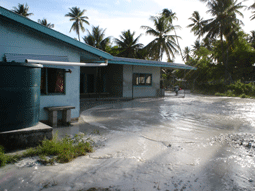
Flooding in South Tarawa, Republic of Kiribati (Photo: Alice Leney)
CURWOOD: Throughout the Pacific Ocean, tropical islands are feeling the early effects of global warming. Located halfway between Hawaii and Australia, the Republic of Kiribati, home to 100,000 people, is one such place, and it’s the focus of this week’s installment in our series "Early Signs: Reports from a Warming Planet."
The series is a collaboration of the UC-Berkeley Graduate School of Journalism, Salon dot com, and Living on Earth to document places around the world where concerns about climate change are already having an impact. Aaron Selverston takes us to Kiribati, a small nation of palms trees, coconuts, and canoes, for a view of life from just six feet above sea level.

Flooding in South Tarawa, Republic of Kiribati (Photo: Alice Leney)
SELVERSTON: From 10,000 feet above the Pacific Ocean, the tropical island of Tarawa resembles the vanishing stage of a waning moon – a razor thin crescent of shimmering green against a vastness of dark ocean, its very existence seems accidental, precarious, as if a single thunderhead could wash it away.
[INSIDE PROP AIRPLANE]
SELVERSTON: Dropping to 1,000 feet, detail of a coconut grove emerges, a carpet of thick, green fans swaying against the wind. On the inside edge of the crescent, a sliver of white sand contains a luminescent lagoon which blends from bright teal along the shoreline to dark turquoise in the center.
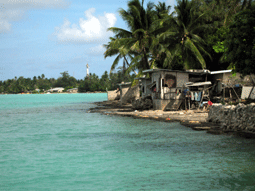
The islands of the Republic of Kiribati average only six feet above sea level. Here, Tarawa's lagoon comes right up to a residence. (Photo: Oskar Garcia)
SELVERSTON: At 500 feet, closing in on the beach, a collection of thatch-hut dwellings appears near the shore.
[WALKING ON BEACH]
SELVERSTON: Down on the sand, a man is walking, contemplating how the shoreline has changed in the thirty years since he last came to this spot: the site of his childhood home. He stops in front of two cement blocks poking out of the sand.
MacKENZIE: Yeah, this is the foundation of the house I grew up in.
SELVERSTON: Uentabo MacKenzie.
[MORE SANDY FOOTSTEPS]
MacKENZIE: That used to be my playground. I remember playing soccer between the house and the trees way back there.
SELVERSTON: MacKenzie, an expert on the South Pacific who authored a World Bank report on the social impacts of climate change, says people all across this island nation, the Republic of Kiribati, are complaining of erosion.
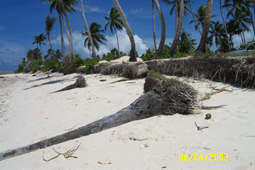
A fallen coconut palm tree waits to be washed out to sea. Erosion in Bonriki, Republic of Kiribati, is pushing the shoreline back. (Photo: Republic of Kiribati Ministry of Environment, Lands, and Agricultural Development)
SELVERSTON: He points out to where the waves are crashing.
MacKENZIE: There used to be coconut right up to there, and big trees even further back than where the water is now. A lot of land has been eroded away. A good fifty meters – fifty, sixty meters – is now under water. So I feel sad coming back to my old playground.
SELVERSTON: More of these difficult changes are likely for I-Kiribati, as people here call themselves. Climate scientists say coral atoll islands throughout the South Pacific could be the most susceptible areas in the world to the effects of global warming.
The Intergovernmental Panel on Climate Change, a U.N.-sponsored group representing the scientific consensus on climate change, says that rising sea levels could cause not just erosion, but flooding and salinization of soils and freshwater.
I-Kiribati from across the islands are already complaining of these problems. MacKenzie, who directs the Kiribati branch of the University of the South Pacific, says that there is little that can be done to stop his nation from getting washed away.
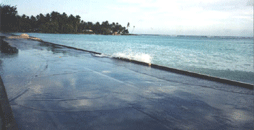
High tide splashing over Taborio causeway, South Tarawa, Republic of Kiribati (Joseph Keyerleber)
MacKENZIE: I think when we look at the changes that are happening in Kiribati, I think it’s a combination of both things: man-made developments and climate change.
SELVERSTON: Climate change could exacerbate these problems.
MacKENZIE: I have no doubt that these islands will be inundated. Or, if they’re not inundated, the livelihood of people will be very difficult, because it will affect saltwater incursion into our water tables, it will affect our plant-life, it will affect the water we drink.
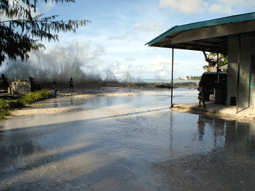
Wave crashing over sandbags on South Tarawa, Republic of Kiribati. (Photo: Alice Leney)
[SOUND OF POURING WATER INTO A SAMPLE JAR, SCREWING THE LID SHUT]
SELVERSTON: In a laboratory in Tarawa’s department of public works, Natasha Kuruppu, an Oxford grad student studying climate change and freshwater supplies, pours a sample she collected from a local well into a beaker.
KURUPPU: People will get sick if saltwater keeps intruding into their freshwater, because you can’t drink it, it’s too salty. And then your internal organs won’t function properly. So we need to protect our freshwater lenses from getting saltwater contamination.
SELVERSTON: Freshwater lenses are cone-shaped bodies of water that literally float on top of denser ocean saltwater. These lenses, which contain the only freshwater in Kiribati other than rainwater tanks, are especially vulnerable to sea level rise. Every inch the ocean comes up pushes a freshwater lens 40 inches closer to the surface, until it disappears entirely. With sea levels expected to rise up to two and a half feet or more in the next century, Kiribati must face losing its main freshwater supply, which could be catastrophic.
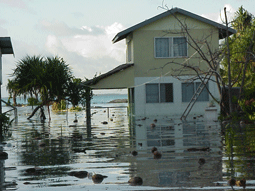
Flooding at the Lagoon Breeze Hotel, South Tarawa, Republic of Kiribati (Photo: Republic of Kiribati Ministry of Environment, Lands, and Agricultural Development)
[INSIDE PROP AIRPLANE]
SELVERSTON: Air Kiribati, the official airline here, is the best way to get to and from the 32 outer islands. Abemama atoll is thirty minutes south of Tarawa by plane. With a population of 4,000, it is far more pristine than the overcrowded Tarawa, which has nearly half of Kiribati’s entire population of 100,000.
[CHORAL MUSIC]
SELVERSTON: On Abemama, a church group is practicing for a singing competition inside a maneaba, a thatch-roofed dwelling common throughout Kiribati. The maneaba is the center of village life, a gathering place for parties, ceremonies, and important decision-making.
[CHORAL MUSIC]
SELVERSTON: As a community elder, Mikaio Rorubuaka sometimes leads songs like these. He sits atop a stone sea wall he built to keep his land from being flooded. He’s noticed that many of his neighbors don’t worry about global warming, because they have faith in God. Their reference point is the biblical flood.
RORUBUAKA: They believe in what the Bible says. During the time of Noah, there was a flood, and the Ark was built to save good people – Noah’s family, animals – but when the flood stopped, God made a promise to Noah not to make any more floods to happen.
SELVERSTON: Mikaio is referring to Genesis 9, in which God tells Noah: “I will establish my covenant with you; neither shall there any more be a flood to destroy the earth.
Next, God tells Noah that a rainbow will always be a sign of this promise. Mikaio says nowadays, when it rains, some people look to the sky for that reassurance.
RORUBUAKA: A rainbow is a sign they always see when it’s raining, and it reminds them whenever they see it in the sky. It’s a symbol, a sign of God’s promise that there won’t be anymore flood.
SELVERSTON: Though Mikaio considers himself Christian, he does not feel that same sense of comfort.
RORUBUAKA: With climatic change, and the effect of the greenhouse, we cannot survive. The islands, particularly the islands in Kiribati, which are very low, will be submerged. And then where would the people be then?
SELVERSTON: Because he's an elder, or “unimane,” Mikaio is also an advisor in his community. He’s carefully considered the role religion plays in people’s views on global warming, and offers this advice to those who remain unconcerned:
RORUBUAKA: You’ve been given your mind by God to use and think about it. So that’s what I’m going to advise, that they should use their mind and think besides believing that nothing is going to happen because God is looking after them.
SELVERSTON: Down the street from the manaeba, nestled amongst a grove of tall coconut palms, Tam Tamere returns home after an unsuccessful fishing trip. For Tam, some disturbing changes have already arrived. He’s noticed a distinct drop in the quantity of tuna – a problem the World Bank says will likely grow worse throughout Kiribati with global warming.
But Tam’s frustrations don’t end there. He can no longer drink the water under his own land. It’s become too salty. And now, even his coconut trees are being affected.
TAMERE: When the place gets salty water, then the coconuts are getting smaller. The water is not so good, and the tree not produce a very big fruit.
SELVERSTON: Tam also says he has witnessed the sea level coming up and has considered the potential long-term result:
TAMERE: We might live like fish, you know, but we pray hard not to live like that.
SELVERSTON: Kiribati President Anote Tong devotes an increasing share of his time to these issues. I caught up with him at Tarawa’s airport, on his way back from the outer island of Butaritari, people there complained to him that taro pits have become flooded with saltwater. Taro is a root crop and staple food in the South Pacific.
TONG: It’s seriously a matter of survival.
SELVERSTON: Tong says that many of his domestic priorities, like economic development, are being sidelined.
TONG: We really cannot discuss issues of development if in the longer term we are facing an issue of survival. So no matter how much we develop in the next decades, if in fifty years time we’re going to go under, what is the purpose of it all?
SELVERSTON: But is it really too late to save the islands? Can’t Kiribati try to adapt in some way?
TONG: We can only adapt so far. For countries like Kiribati is that we may have already gone well beyond adaptation. Maybe we’ve reached the stage where very little can be done now to reverse the process.
SELVERSTON: A study of glacial melt published in the journal Science in February found that Greenland’s glaciers are losing mass twice as fast as they were ten years ago, most likely because of global warming. Glacier expert Eric Rignot, who authored the report, later said that current predictions for sea level rise, are probably low.
RIGNOT: By many accounts now we’ve already exceeded a CO2 threshold in the atmosphere for which Greenland has any stable ice, for which west Antarctica has any stable ice.
SELVERSTON: Bob Dunbar is professor of environmental and geologic sciences at Stanford University, and has spent the last 15 years studying climate in Kiribati.
DUNBAR: If both of those glacial systems melt away, sea level’s gonna rise about 16 to 18 meters.
SELVERSTON: That’s over fifty feet. The Republic of Kiribati averages six feet above sea level.
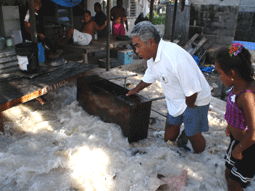
A man in South Tarawa, Republic of Kiribati, keeps his belongings from getting washed away by floodwater. (Alice Leney)
SELVERSTON: Which leads Professor Dunbar to ask a question that, if he was talking about America, might seem almost unimaginable.
DUNBAR: How many years does it take to plan for a successful movement of a nation state?
SELVERSTON: President Anote Tong:
TONG: So now we are challenging the international community: are you prepared to do anything about it?
SELVERSTON: Tong says so far he can only hear his own echo.
[MUSIC: Kiribati Church Choral Singers]
SELVERSTON: For Living On Earth, I’m Aaron Selverston or Tarawa, Republic of Kiribati
CURWOOD: Next week, our series “Early Signs: Reports from a Warming Planet” continues in Bangladesh, a river delta nation where there is a pressing concern about the potential effects of global warming.
MAN: The numbers of people that will probably have to be relocated, will have to move, will certainly have to change their livelihoods if they want to survive, are in the tens of millions.
CURWOOD: “Early Signs” is a collaboration of the UC-Berkeley Graduate School of Journalism, Salon dot com, and Living on Earth. To read a print version of the story about Kiribati and see photos of the island, visit our website, Living on Earth dot org. That’s Living on Earth dot O-R-G.
 |
 |  |  |
Related link:
To see a print version of this story, and other reports in this series, click here
[CHORAL SINGERS]
CURWOOD: We leave you this week in the middle of another Pacific Island.
[BIRD CALLS, JUNGLE SOUNDS]
CURWOOD: Jean Roché recorded this dawn chorus in the jungles along the banks of the Kinabatangan River in Borneo.
EARTHEAR: “Kinabatangan Jungles (Borneo)” recorded by Jean C. Roche from ‘Dawns of the World, Vol. 1’ (Sittelle – 1996)
CURWOOD: You can hear our program anytime on our website or get a download for your iPod or other personal listening device. The address is loe.org that’s loe dot o-r-g. You can reach us at comments@loe.org once again comments at loe dot o-r-g. Our postal address is 20 Holland St. Somerville, Massachusetts 02144. And you can call our listener line at 800-218-9988. That’s 800-218-9988. CDs and transcripts are $15.
Living on Earth is produced by the World Media Foundation. Our crew includes Ashley Ahearn, Chris Ballman, Eileen Bolinsky, Jennifer Chu, and Ingrid Lobet - with help from Christopher Bolick, Kelley Cronin, and James Curwood. Thanks this week to the folks who run Cornell University Studios. And we bid a fond farewell to Michelle Kweder, who is off to the world of human services. Our interns are Bobby Bascomb and Emily Taylor. Our technical director is Dennis Foley. Alison Dean composed our themes. You can find us at LOE dot org. I’m Steve Curwood. Thanks for listening.
ANNOUNCER: Funding for Living on Earth comes from the National Science Foundation, supporting coverage of emerging science; Kashi, maker of all natural cereals and snacks for health and wellness. Kashi. Seven whole grains on a mission; and Stonyfield Farm. Organic yogurt, smoothies and milk. Ten percent of profits are donated to efforts that help protect and restore the earth. Details at Stonyfield dot com. Support also comes from NPR member stations, the Ford Foundation, the Geraldine R. Dodge Foundation, The Welbourne Ecology Fund and the Saunders Hotel Group of Boston's Lennox and Copley Square Hotels. Serving you and the environment while helping preserve the past and protect the future, 800-225-7676.
ANNOUNCER2: This is NPR, National Public Radio.
Living on Earth wants to hear from you!
Living on Earth
62 Calef Highway, Suite 212
Lee, NH 03861
Telephone: 617-287-4121
E-mail: comments@loe.org
Newsletter [Click here]
Donate to Living on Earth!
Living on Earth is an independent media program and relies entirely on contributions from listeners and institutions supporting public service. Please donate now to preserve an independent environmental voice.
NewsletterLiving on Earth offers a weekly delivery of the show's rundown to your mailbox. Sign up for our newsletter today!
 Sailors For The Sea: Be the change you want to sea.
Sailors For The Sea: Be the change you want to sea.
 The Grantham Foundation for the Protection of the Environment: Committed to protecting and improving the health of the global environment.
The Grantham Foundation for the Protection of the Environment: Committed to protecting and improving the health of the global environment.
 Contribute to Living on Earth and receive, as our gift to you, an archival print of one of Mark Seth Lender's extraordinary wildlife photographs. Follow the link to see Mark's current collection of photographs.
Contribute to Living on Earth and receive, as our gift to you, an archival print of one of Mark Seth Lender's extraordinary wildlife photographs. Follow the link to see Mark's current collection of photographs.
 Buy a signed copy of Mark Seth Lender's book Smeagull the Seagull & support Living on Earth
Buy a signed copy of Mark Seth Lender's book Smeagull the Seagull & support Living on Earth

